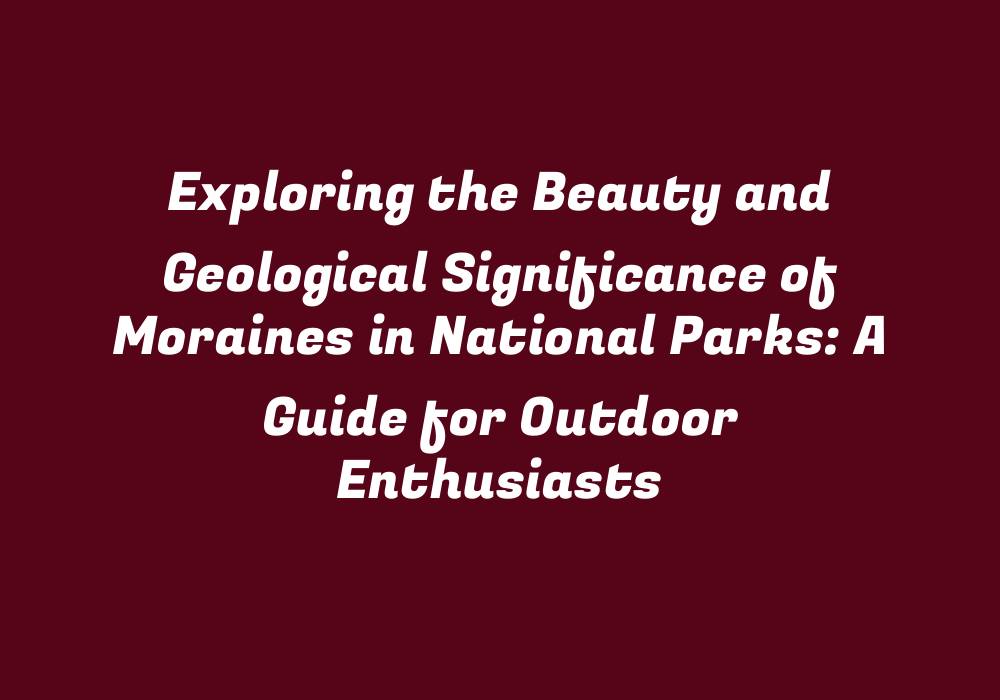Introduction
Moraines have always been an intriguing part of the natural landscape. These accumulations of unconsolidated rocks, glacial till, and sediments are remnants of a glacier’s movement throughout time. As global warming melts ice sheets in several regions worldwide, moraines are becoming increasingly visible across different national parks. In this article, we will delve into the beauty and geological significance of moraines in these protected areas while also offering valuable guidance to outdoor enthusiasts seeking to explore them.
Understanding Moraines
Moraines form when a glacier moves over land and deposits materials along its pathways, either as it advances or retreats. These landform features are crucial for understanding glaciological processes and their impact on the environment. They also provide evidence of past ice sheets, giving us insight into Earth’s climate history.
Moraines come in three distinct types: ablation (rock fragments accumulated during melting), lateral (deposits at the sides of a glacier as it advances or retreats), and terminal (material left behind by the end of a glacier as it recedes). Understanding each type is essential when studying moraines in national parks.
The Beauty of Moraines
Moraines are a testament to Earth’s natural beauty. In their varied shapes and forms, they represent the dynamic interplay between geological processes, glacial movements, and landscape transformations over time. The presence of moraines in national parks not only highlights the unique natural environments within these protected areas but also adds to their scenic appeal for visitors.
Moraines can be found in many popular national parks around the world, including Glacier National Park in Montana (USA), Mount Cook National Park in New Zealand, and Vatnajökull National Park in Iceland. Each location offers a distinctive set of visual experiences for outdoor enthusiasts to explore and appreciate these unique landforms.
Geological Significance of Moraines
Moraines hold immense geological significance, serving as important clues to the past movements and behaviors of glaciers in various regions of the world. By examining their composition, distribution patterns, and ages, scientists can reconstruct climate histories, estimate past glacier sizes, and better understand how these dynamic systems shape our planet’s landscape.
In national parks that preserve large-scale geological records, moraines are critical for understanding glacial activity over millennia. The study of moraine formations has contributed to our knowledge about past ice sheets and their contribution to climate change, as well as the impact on ecosystems and biodiversity in different regions.
Exploring Moraines: Tips and Precautions for Outdoor Enthusiasts
To get the most out of your moraine exploration experience in national parks, it is essential to follow some basic guidelines for a safe and enjoyable visit.
1. Research before visiting: Learn about the park’s geology and history, focusing on its moraines, glacial landscapes, and specific landforms. Understanding their formation processes will help you appreciate them even more during your visit.
2. Prepare for variable conditions: Weather in glaciated areas can be unpredictable and change rapidly. Dress appropriately according to the local climate, pack warm clothing, waterproof gear, and proper footwear for navigating uneven terrain.
3. Respect the environment: Always practice leave no trace principles when exploring moraines and other natural features in national parks. Protect local ecosystems by not removing any rocks or artifacts from their original setting.
4. Follow park regulations: Each national park has unique guidelines for visitor safety and resource conservation. Make sure to read up on these rules before your visit, particularly if you plan to venture off-trail or engage in activities such as rock climbing or hiking around moraines.
5. Be cautious of hazards: Moraine environments can harbor hidden dangers like steep inclines, loose rocks, and sudden weather changes. Be aware of potential risks while exploring these areas and exercise caution at all times.
Conclusion
Moraines hold a unique beauty and immense geological significance for both the scientific community and outdoor enthusiasts alike. By understanding their formation processes, history, and environmental implications, we can appreciate our planet’s natural wonder and gain insights into its ever-evolving landscape. As global warming continues to affect glaciers around the world, moraines will continue to captivate us with their stunning landscapes, intriguing stories of Earth’s past, and a glimpse of the future as we face the challenges posed by climate change.
